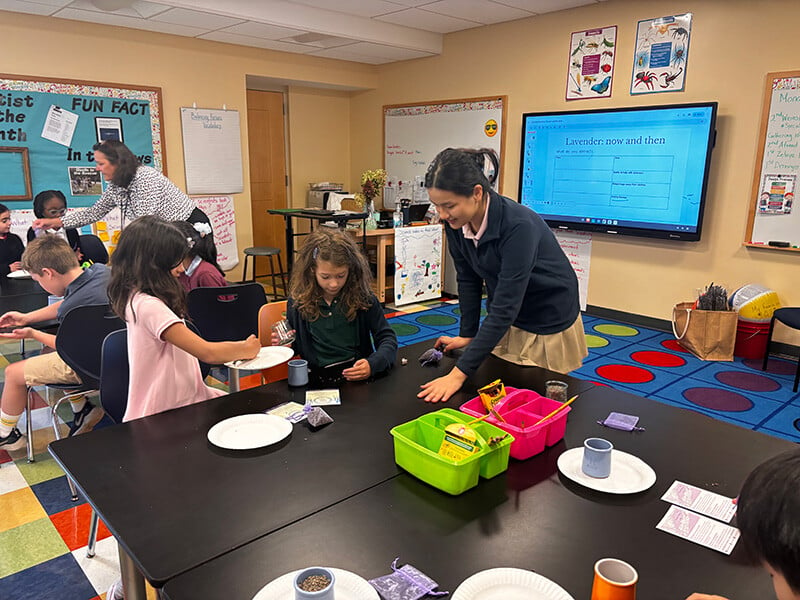Second Grade celebrates LI with heart, hands-on learning, home-island pride
04-23-25
Subscribe
Close
Fill out the form below to receive updates on the latest and greatest within the Friends Academy community.

Sitting in a circle atop a patchwork-colored rug, a small group of students offered their scientific observations of two piles of lavender plants. One hand after another shot up in Katie Schlicht’s second-grade Science class.
“That one is more grey because it was harvested a longer time ago,” commented one student. “That one smells stronger than the other one,” offered another. “One is dry and one is fresh?” queried a third.

“Yes! Friend speaks my mind. Good job, friends!” enthusiastically responded senior Lyra-Anne Ku to the group. “The dried one does smell much better and we always use dried lavender. If we used wet, it would get moldy and perhaps make you sick,” she said.
During the past year, Lyra-Anne embarked on a personal passion project in which she researched and then planted a new teaching garden – the Colonial Medicinal Herb Initiative – behind the Matinecock Meeting House. The garden provides a look into the medicinal herbs planted by both Native Americans and colonists at the time the Matinecock Meeting House was first constructed (1725) and throughout the American Colonial period. The garden features a variety of herbs, including basil, bergamot, calendula, coriander, echinacea, fennel, foxglove, hollyhock, lavender, mint, rosemary, rue, sage, thyme, and yarrow. “Each herb has many properties and was used by colonists for various purposes, from treating illnesses and injuries, to flavoring foods, and making perfumes,” described Lyra-Anne.
Senior Lyra-Anne Ku spreads her love of medicinal herbs and plants to Friends Academy 2nd graders in the classroom and in a new teaching garden she planted behind the Matinecock Meeting House.
Lyra-Anne’s love of gardening, which started during her early years in a Waldorf school, has now blossomed into a college pursuit, where she hopes to study how history and science work together to uncover the past and create solutions for the future. “We had a gardening class in my old school where we harvested tomatoes and raspberries, and grew our own mushrooms,” shared Lyra-Anne. “Gardening has been a major part of my life and now I’m interested in the history of science,” she said.
As an off-shoot to her research, Lyra-Anne reached out to Mrs. Schlicht to ask about presenting her work and guiding Friends Academy second graders through a curriculum she designed along with a hands-on project – assembling homemade lavender sachets from the lavender seeds similar to the lavender plants grown in the Colonial Medicinal Herb Initiative teaching garden, which students also toured. “Remember, if your sachet stops smelling, just squeeze it again,” advised Lyra-Anne, as pairs of students worked together to transfer the lavender seeds into a small cloth bag.


“It was really nice to see her excitement around designing a project for younger students,” said Mrs. Schlicht, who mentored Lyra-Anne. “We discussed ways to tweak her presentation, focusing on how to keep students engaged, what this age group could manage and how to balance the time devoted to the presentation and activity.” She was impressed by Lyra-Anne’s organization and eagerness. “We determined that second grade was the best fit for her curriculum because second graders will be studying about “Long Island Long Ago” as part of their social studies curriculum. The project was a wonderful integration of science and social studies.”

Back in the classroom, it didn’t take long for students to begin making their own connections to Lyra-Anne’s research, as she began to paint a vibrant picture of the herb’s benefits – aiding soreness through lavender baths, keeping bugs away from clothing, and aromatherapy. “When I get sick, my mom makes this medicine out of honey and lemon,” a student shared. “You see,” answered Lyra with a knowing smile. “That relates to what we were talking about with medicinal remedies.”
As the class closed, each student received a small bouquet of fresh lavender to practice drying at home. “It’s cool to see that you are interested in something I am interested in,” remarked Lyra-Anne.
To learn more about the role of herbs as medicine in the lives of early Americans, Lyra-Anne has also created a written and audio guide to her garden which can be accessed at https://bit.ly/colonialherbgardenpamphlet and https://bit.ly/colonialherbgardenaudio.
Video by Alvin Caal/Friends Academy
Did you enjoy this post? Here are a few more we think you'd be interested in:
Fill out the form below to receive updates on the latest and greatest within the Friends Academy community.